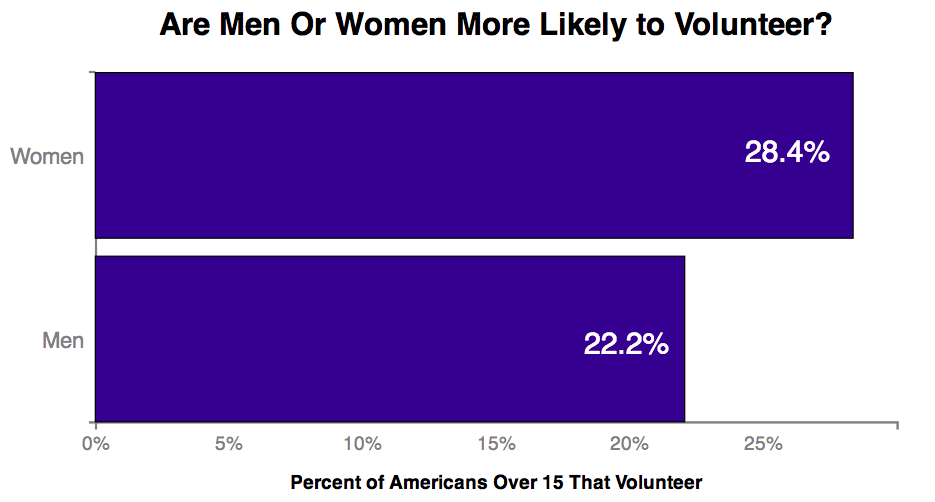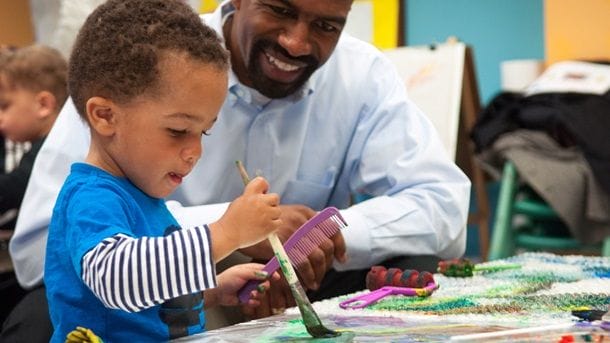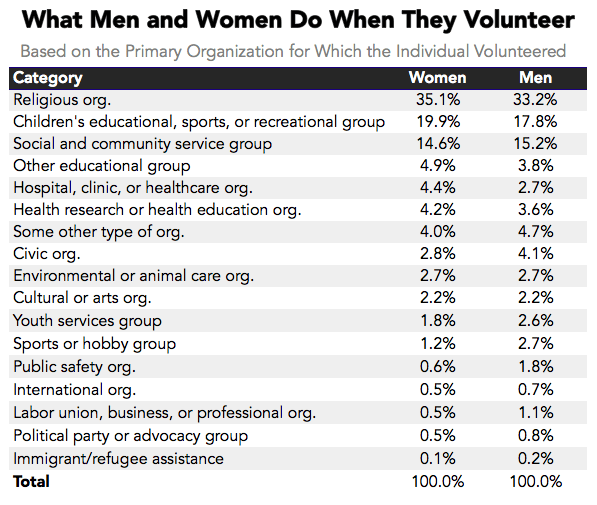When YCore, an organization that promotes volunteerism among young professionals, sent out its inaugural recruitment letters, the leadership was stunned by one aspect of who they heard from. Though the letters were sent out to a gender balanced group, 95% of the responses came from women.
Though Olivia Bryant, the CEO of YCore, had observed the gender gap at other nonprofits, she was still surprised at the discrepancy. She knew women often dominated volunteer spaces, but 95%? The YCore team set to work to recruit men, and they have since increased the proportion of applications from men to about 25%.
YCore’s experience is certainly extreme, but the gender imbalance they observed is no fluke. Volunteerism in the United States is substantially more common among women than men. According to a 2014 survey, on average, women are nearly 30% more likely to volunteer.
So are women just the more altruistic sex? Or is this a reflection of other social realities, like fewer women choosing to be in the labour force, or working part-time? Our data analysis reveals that no matter how you cut it, women do seem to have a higher proclivity for volunteering. We explore why this might be.
***

American Red Cross volunteers in California.
25.3% of Americans choose to volunteer at least once a year, and nearly half of the individuals that volunteer do so an average of more than one hour per week. These numbers come from a September 2014 survey of Americans ages 15 and older conducted by the Bureau of Labor Statistics. Volunteering is defined as any unpaid work performed for an organization. It can include anything tutoring English at the local library, coaching your child’s basketball team, or helping your church with a fundraiser.
Not all Americans are equally likely to volunteer. The probability that a given person will volunteer is impacted by their age, income, education level and, not least of all, by gender. In 2014, 28.4% of women volunteered at least once, while only 22.2% of men did so.

This is a long-standing trend. Surveys from previous years show a similar difference in the civic engagement of women and men.
In order to better understand this discrepancy, we decided to look at whether this pattern was true irrespective of age, income or working status. The Interuniversity Consortium for Political and Social Research makes individual level data from the survey available, which allowed us to dig deeper.
The following chart displays the percentage of Americans that volunteer at any given age. We can see from this chart that the likelihood of volunteering changes a great deal over our lives, but that women are always more inclined than men.

Volunteerism peaks during two different periods in our lives. The first spike is at the end of high school. As Juniors and Seniors in high school, many people participate in organizations that compel them to perform community service. Many high schools require community service in order to graduate. But once Americans finish high school, volunteerism becomes less likely. We seem to be at our most selfish in our early 20s.
The likelihood of volunteering rises again in the late 30s and reaches its zenith in the early 40s. Over 30% of Americans between the ages of 40 and 45 volunteer. This is related to the increased likelihood of volunteering when having children. While having a baby actually makes you less likely to volunteer — only 17% of people whose first child is 2-years-old or less volunteer — when their child reaches school age, people become dramatically more likely to volunteer. Over 35% of parents with children between 6-13 volunteer, often for a school activity.
Though women volunteer more than men at all ages, the effect of having children does seem to be greater for women. We can see in the chart above that the gender difference is largest between 35 and 45, when 10% more women volunteer than men.

Parents frequently volunteer for their kids’ school.
Economic status is a key determinant of how likely a person is to volunteer. The sociologist and volunteerism researcher Hiromi Taniguchi writes that volunteering is “a privilege as well as a responsibility.” People who find themselves in poverty or struggling to find a job are unlikely to feel that they can spend time and effort volunteering. People from a family with incomes of over $150,000 are more than twice as likely to volunteer than those from families with less than $50,000, and those who work full-time are nearly 20% more likely to volunteer than those who are unemployed.
Yet even when we only compare men and women who work full-time, we still find a large gender gap in terms of who volunteers. 30.1% of women who work full-time also find the time to volunteer in comparison to just 23.8% of men.

Given the importance of income on the likelihood to volunteer, we wondered whether the gender gap might disappear at different levels of family earnings. These next three charts display the percentage of adult men and women working full-time who volunteer by family income and age.

Again, no matter the income level, age or working status, women are more likely to volunteer. Even when you just compare young people who work full-time on the higher end of the pay scale, women come out on top by almost 10%. Previous academic studies have found similar results.
***
We wondered if looking at what women and men actually do when they volunteer might give us some insight into the gender imbalance. The table below shows the proportion of men and women, of those who volunteer, who volunteer for different types of groups. Only the primary volunteer organization of the individual is included, so each individual is only counted once. For example, the main volunteer organization for 35.1% of women is a religious one, while this is only true of 33.2% of men.

Though there are differences in the types of institutions men and women volunteer through, they are not huge. Women are more likely to volunteer through religious organizations, education groups and health-related organizations, while men are more likely to be involved in civic organizations (such as Rotary International), a sports group or public safety organization.
Overall, looking at the groups that women volunteer for does not give us much of a clue to the discrepancy, but it does point to the gendered nature of certain types of volunteering.
***
So what accounts for the volunteer gap between the sexes?
One common explanation is cultural expectations. Men are often conditioned in America to think that they should devote all of their energies to generating income. The sociologist Hiromi Taniguchi found that when men and women are out of work, women increase their time spent volunteering, while men spend all of their time looking for work.
Jesse Eubanks of the non-profit Love Thy Neighborhood blames the “suspended adolescence” of young American men today. He sees a large number of young men unwilling to embrace responsibility. “Man-boys” who are not ready to take on the risks and relationships of being in a community. The guys in Knocked Up probably were not doing much volunteer work.
Energize Inc., a consultancy for nonprofits, published an entire guide dedicated to helping volunteer organizations recruit men. They suggest that one problem is that much of the recruiting material from organizations is oriented towards women. Men may feel like the organization is a female space when they only see female faces in brochures and other materials. Another challenge is that many organizations already have a preponderance of women, and any new men will feel that they don’t belong. Being the first guy can be be uncomfortable.
Olivia Bryant, the CEO of YCore, told us that getting women involved in volunteering is an easy pitch: “Women are attracted to the community aspects of volunteering. Volunteering is a chance to meet like-minded women. It’s a social event where they can be at ease.” To attract men, she has found it is more effective to “frame volunteerism as professional development.” She finds that talking about the practical benefits of developing skills and creating a network appeals more to men.
When asked it was important to have men volunteer, Bryant responded that it was the same reason she wanted people of different races and economic backgrounds participating in her organization. “We want our group of volunteers as diverse as possible,” Bryant explained. “Men can bring a different perspective.”
***
By any way you slice it, when it comes to demonstrating altruism through volunteering, women are simply dominating men. Regardless of whether they work or not, how old they are, or how rich they are, women just volunteer more.
![]()
For our next post, we tell the story of Esurance’s old mascot, who was discontinued after being made into cartoon porn. To get notified when we post it → join our email list.
This post was written by Dan Kopf; follow him on Twitter here.



